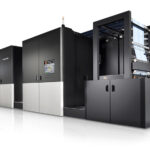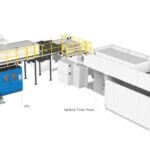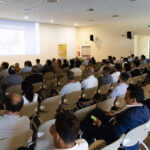The latest high performance digital plates and the DigiFlow “open” exposure system by DuPont. E.P.
DuPont Packaging Graphics confirms its commitment to R&D and focuses on photopolymeric sleeves, digital plates and thermal engraving. Domingo Valles, manager of Projets Cyrel® Round Imaging Technologies, commented on the topic during the most recent Labelexpo Europe: «Photopolymeric plates offer significant advantages, usually in converting labels and flexible packaging, since they simplify production of the plate and enable the printer to be responsive and competitive. Along with thermal engraving, which is set for some important developments, they represent a priority of our Research division and have recently given us a lot of satisfaction.
Starting in 2000, we have introduced an entire line of digital plates: solvent and thermal, productive and eco-compatible. And today, at Labelexpo Europe, we are showing our latest accomplishments in quality flexographic printing, which constitute a high performance and economical solution: the “open” exposure system DigiFlow and digital Cyrel® Performance Plates (DSP and DFP), announced at the most recent drupa and available on the market since last year».

An open system. DuPont’s Cyrel® Digiflow produces 1:1 reproductions on Cyrel® digital plates («inconceivable with a standard workflow», says Domingo Valles). Moreover, the system enables obtaining hight impact prints even on corrugated cardboard and flexible packaging, thanks to a hybrid flat top dot, and optimizes solid screening software such as Esko HD Flexo Microcell. DigiFlow obtains optimal results in combination with a CDI equipped with high resolution optics and helps enhance the competitiveness of flexographic printing with respect to other technologies.
DuPont thus developed this system firstly in order to pursue quality objectives, but also with full attention to making its use easy and economically sustainable: «It’s an open system – highlights the manager – that does not limit the user to DuPont products, conceived in order to give converters that which they truly need: flexibility, economy and quality, in order to keep up with technological progress and have at their disposal the tools that create value without requiring heavy investments. For this reason, it is easy to adopt DigiFlow on installations already in use. All it takes is to reconfigure the existing exposure modules in such a way as to generate a nitrogen-based atmosphere that makes possible digital plates with effectively a 1:1 reproduction and the famous flat dots which enhance print precision and minimize wash board defect on corrugated cardboard».
 High performance plates. As for the new digital plates, they have been developed with the objective, shared by all suppliers active on the market, of obtaining adequate ink density for flexographic printing. «The new generation of DuPont plates – states Domingo Valles – guarantee this result, along with a good sized minimum dot and reduced dot gain. Both the DuPontTM Cyrel® DSPs, processed with solvent, and the DuPontTM Cyrel® FAST DFP, processed thermally, can be used in a standard workflow, with all platesetters LAM-based, and do not require investing in new digital preprinting, exposure or lamination equipment. We call them “Performance Plates” because their micro-structured surface has been designed in such a way as to obtain truly optimal levels of SID and smoothness and, ultimately as obtained with Cyrel® DigiFlow with Microcell and other technologies, they offer a print quality in the high lights similar to DPR/DFH/DFR».
High performance plates. As for the new digital plates, they have been developed with the objective, shared by all suppliers active on the market, of obtaining adequate ink density for flexographic printing. «The new generation of DuPont plates – states Domingo Valles – guarantee this result, along with a good sized minimum dot and reduced dot gain. Both the DuPontTM Cyrel® DSPs, processed with solvent, and the DuPontTM Cyrel® FAST DFP, processed thermally, can be used in a standard workflow, with all platesetters LAM-based, and do not require investing in new digital preprinting, exposure or lamination equipment. We call them “Performance Plates” because their micro-structured surface has been designed in such a way as to obtain truly optimal levels of SID and smoothness and, ultimately as obtained with Cyrel® DigiFlow with Microcell and other technologies, they offer a print quality in the high lights similar to DPR/DFH/DFR».
DuPont tested the plates with the collaboration of anilox, support, ink and machine manufacturers, with whom it implemented a valuable practice of collaboration – Bobst, for example, or, in Italy, Uteco. In such a way, was the effectiveness of the micro-alveoles that characterize the photopolymer demonstrated. These are capable of retaining ink, thus enhancing yield, reaching quality standards comparable to those of rotogravure. «The numerous visitors at Labelexpo appreciated – Domingo Valles reports – and showed confidence in this solution: having come out of the crisis, demand is slowly beginning to rise, even in the less dynamic markets in the developed countries, flexography moves forward».













